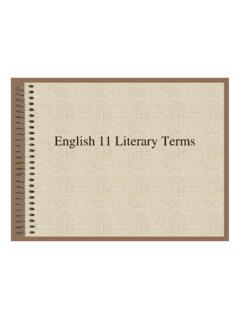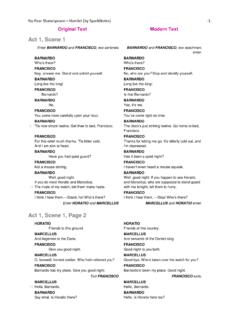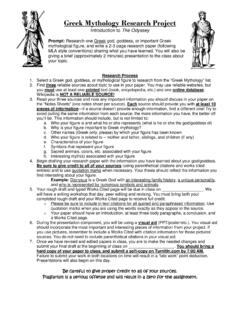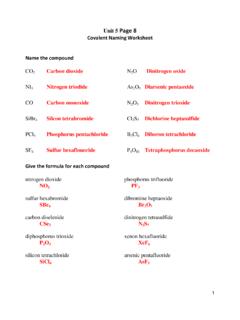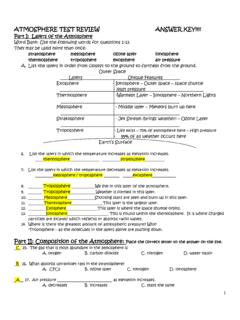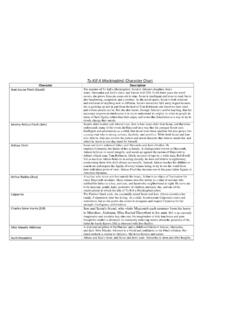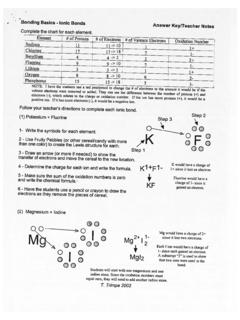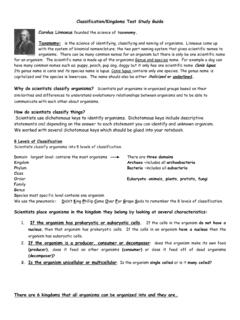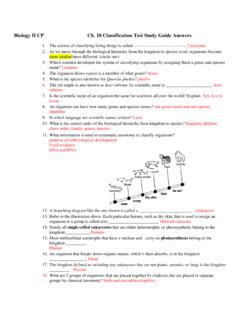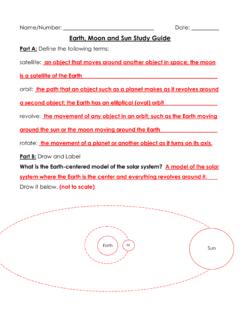Transcription of Literary Devices: Literature (Short Stories/Novels)
1 Literary Devices: Literature (Short Stories/Novels) AP Literature & Composition Types of Fiction Allegory A story in which people, objects, and events stand for abstract qualities. , Nathaniel Hawthorne s Dr. Heidegger s Experiment can be interpreted as an allegory with each of the characters representing an abstract quality---for instance, Mr. Medbourne might represent greed. Anecdote A short narrative. Autobiography An account of a person s life written by that person. , Benjamin Franklin s autobiography. Biography An account of a person s life written by another person. , Carl Sandburg s biography of Abraham Lincoln. Fable A short story that illustrates a moral, often using animals as characters.
2 , The Tortoise and Hare. Gothic Literature characterized by grotesque characters, bizarre situations, and violent events. , Edgar Allan Poe s The Tell-tale Heart. Legend A story passed down orally, frequently over generations, and popularly believed to have an historical basis, sometimes exaggerated. Myth A traditional story, usually concerning a superhuman being or unlikely event that was once widely believed to be true. , myths of Greek gods. Narrative An oral or written account of an event or series of events. Parody A humorous, exaggerated imitation of another work. , Thurber s The Princess and the Tin Box is a parody of a fable (see fable ). Short story A fictional work that usually can be read in one sitting.
3 , Edgar Allan Poe s The Black Cat. Tall tale A humorously exaggerated story about impossible events and/or heroes with extraordinary abilities. , Paul Bunyan. Magical Realism Fiction that maintains a discourse appropriate to an objective and realistic narrative, while recounting fantastic or supernatural events alongside commonplace happenings. Magic realism provides much of the power in a number of South American writers, notably Gabriel Garcia Marquez (One Hundred Years of Solitude, 1967), but the technique has been used by Milan Kundera, Salman Rushdie, Robert Kroetsch, Jack Hodgins and Peter Carey, among others. Kinds of Characters Antagonist Character, force or other thing in opposition to the protagonist.
4 , in Homer s Odyssey, the Cyclops is Odysseus protagonist. Dynamic character Character who changes during the story. , Odysseus in Homer s Odyssey. Flat character Character with few personality traits. , the nurse in Shakespeare s Romeo & Juliet. Protagonist Central character; sometimes a hero. , John Proctor in Arthur Miller s The Crucible. Round character Character with many personality traits. , Juliet in Romeo & Juliet. Static character Character who does not change during the story. , the narrator in Poe s The Tell-Tale Heart. Character Development Direct characterization When the narrator directly describes the character s personality. , in Saki s short story The Open Window, when Vera is described by the narrator as a very self-possessed young lady of fifteen.
5 Indirect characterization When a character s personality is revealed through his/her actions or words. , in Euripides play Medea, when Medea reveals her violent and vengeful character by brutally killing her enemies. Motivation The thing or person that causes a character to do something. , in Saki s short story The Open Window, Mr. Nuttel s motivation to leave is his fear of ghosts. Plot Structure Climax Where the reader s interest and emotional intensity are at their peak. , Mr. Nuttel s seeing ghosts and his abrupt departure. Exposition Provides important background information at the start of the rising action and introduces the setting, characters, and conflict(s).
6 Falling action The events in a story after the climax; sometimes the resolution/denouement is also falling action. Plot The action of a story. , the plot of The Open Window is that Mr. Nuttel visits a family and is informed by the daughter that her father and brothers were killed in a hunting accident a year ago and her mother still awaits their return through an opened Etc. Resolution/Denouement When action in the story is resolved; occurs after the climax. , in The Open Window, when Vera explains Mr. Nuttel s sudden departure. Rising action The events in a story before the climax that advance the plot by adding complications and/or expanding conflicts. Development Techniques 1st person point of view When a character tells the story.
7 , the narrator in Poe s The Tell Tale Heart 3rd person limited point of view When the narrator knows and describes only what one character knows. , Nathaniel Hawthorne s Young Goodman Brown. 3rd person omniscient point of view When the narrator is all-knowing. External conflict Struggle between a character and something or someone outside of himself. , in Homer s Odyssey, Odysseus confrontation with Scylla. Flashback Description of something that occurs before the story and interrupts the narrative. , william faulkner s A rose for Emily opens with Miss Emily s funeral, followed by a flashback that recounts how, when she was alive, Colonel Sartoris exempted her from paying taxes.
8 Foreshadowing Hints about what will happen in the story. , The witches prophesy in Shakespeare s Macbeth. In medias res Literally: in the middle of things. When a story begins in the middle of the action. Internal conflict Struggle within a character s mind. , Odysseus decision to go home rather than stay with Circe. Point of view Refers to the narrative perspective from which events in a story are told. , 3rd person omniscient. Stream of consciousness A writing technique developed to present the flow of a character s seemingly unconnected thoughts, responses, and sensations. , In The Love Song of J. Alfred Prufrock, Eliot uses this technique to reveal the jumble of thoughts that flow through Prufrock s mind.
9 Miscellaneous Concepts Analogy A comparison to clarify an action or a relationship. , In My Dungeon Shook, James Baldwin draws an analogy between his nephew s probable reaction to seeing the stars shining in daytime, and white people s reaction to seeing blacks moving out of their fixed places. Aphorism Brief statement, usually one sentence that expresses a general principle or statement about life. , Whoso would be a man must be a nonconformist. Clich An overused expression that has lost its freshness. , happy as a lark, white as snow, etc. Dramatic irony When the reader or viewer knows something that a character does not know; as in a horror movie. , in Romeo & Juliet, the reader s knowledge that Juliet is not really dead by drinking the poison.
10 Epiphany A sudden understanding or realization that prior to this was not thought or understood. , when the women in Trifles suddenly understood the motive for the murder. Explication An explication is not a paraphrase, nor a summary, nor a rewording (though it may include succinct paraphrase), but a commentary revealing the meaning of the work. To this end it calls attention, as it proceeds, to the connotations of words, the function of rhymes, the shifts in point of view, the development of contrasts/polarities, and any other contributions to the meaning , of close reading, or explication de texte Euphemism Word or phrase that takes the place of a harsh, unpleasant, or impolite reality.
